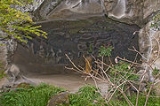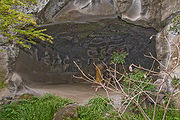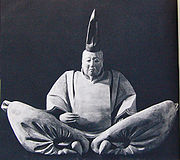
Meigetsu-in
Encyclopedia
is a Rinzai Zen
temple of the Kenchō-ji
school in Kita-Kamakura, Kanagawa, Japan
. Famous for its hydrangeas, it's also known as The Temple of Hydrangeas (ajisai-dera). The main object of worship is goddess Shō Kannon (聖観音).
 Meigetsu-in was built by Uesugi Norikata of the powerful Uesugi clan
Meigetsu-in was built by Uesugi Norikata of the powerful Uesugi clan
, and the name itself derives from Norikata's own posthumous name (Meigetsu). According to 350-year-old records it was originally just the guest rooms of a much bigger temple called which was closed by the government during the Meiji period. Zenkō-ji was a temple of considerable prestige, being one of the Rinzai Zen temples classified as ' onMouseout='HidePop("43455")' href="/topics/Five_Mountain_System">Five Mountains
(. Zenkō-ji however didn't survive the anti-Buddhist clampdown (Haibutsu kishaku
) that followed the Meiji Restoration
. Meigetsu-in is the owner of a famous 13th century statue of Uesugi Shigefusa, founder of the Uesugi clan. He is dressed in the picturesque clothes of the dignitaries of the Kamakura period. The statue is a National Treasure
.

Zen
Zen is a school of Mahāyāna Buddhism founded by the Buddhist monk Bodhidharma. The word Zen is from the Japanese pronunciation of the Chinese word Chán , which in turn is derived from the Sanskrit word dhyāna, which can be approximately translated as "meditation" or "meditative state."Zen...
temple of the Kenchō-ji
Kencho-ji
Kenchō-ji is a Rinzai Zen temple in Kamakura, Kanagawa Prefecture, Japan, which ranks first among Kamakura's so-called Five Great Zen Temples and is the oldest Zen training monastery in Japan. These temples were at the top of the Five Mountain System, a network of Zen temples started by the Hōjō...
school in Kita-Kamakura, Kanagawa, Japan
Japan
Japan is an island nation in East Asia. Located in the Pacific Ocean, it lies to the east of the Sea of Japan, China, North Korea, South Korea and Russia, stretching from the Sea of Okhotsk in the north to the East China Sea and Taiwan in the south...
. Famous for its hydrangeas, it's also known as The Temple of Hydrangeas (ajisai-dera). The main object of worship is goddess Shō Kannon (聖観音).
History

Uesugi clan
The was a Japanese samurai clan, descended from the Fujiwara clan and particularly notable for their power in the Muromachi and Sengoku periods ....
, and the name itself derives from Norikata's own posthumous name (Meigetsu). According to 350-year-old records it was originally just the guest rooms of a much bigger temple called which was closed by the government during the Meiji period. Zenkō-ji was a temple of considerable prestige, being one of the Rinzai Zen temples classified as ' onMouseout='HidePop("43455")' href="/topics/Five_Mountain_System">Five Mountains
Five Mountain System
The system, more commonly called simply Five Mountain System, was a network of state-sponsored Zen Buddhist temples created in China during the Southern Song Dynasty . The term "mountain" in this context means "temple" or "monastery", and was adopted because many monasteries were built on isolated...
(. Zenkō-ji however didn't survive the anti-Buddhist clampdown (Haibutsu kishaku
Haibutsu kishaku
is a term that indicates a current of thought continuous in Japan's history which advocates the expulsion of Buddhism from Japan...
) that followed the Meiji Restoration
Meiji Restoration
The , also known as the Meiji Ishin, Revolution, Reform or Renewal, was a chain of events that restored imperial rule to Japan in 1868...
. Meigetsu-in is the owner of a famous 13th century statue of Uesugi Shigefusa, founder of the Uesugi clan. He is dressed in the picturesque clothes of the dignitaries of the Kamakura period. The statue is a National Treasure
National treasures of Japan
National Treasures are the most precious of Japan's Tangible Cultural Properties, as determined and designated by the Agency for Cultural Affairs...
.
Points of interest

- The temple itself with its beautiful round window (see photo above)
- The temple's garden contains one of the celebrated , the Kame no I (瓶の井)
- The karesansui, a garden of raked sand, rocks and plants representing legendary Buddhist Mount Shumi.
- The yaguraYagura (tombs)are artificial caves used during the Middle Ages in Kamakura, Kanagawa Prefecture, Japan, as tombs and cenotaphs. It is likely that they were used only as tombs in the beginning, and that later they started being used as cenotaphs too. The dead are usually samurai, but priests and even artisans...
cave dug on the side of a hill is the largest in Kamakura. The small tower at its center is thought to be Norikata's tomb - Hōjō TokiyoriHojo TokiyoriHōjō Tokiyori was the fifth shikken of the Kamakura shogunate in Japan. He was born to Hōjō Tokiuji and a daughter of Adachi Kagemori....
's grave - The hydrangeas in the garden. The flowers, however famous, are apparently just a recent addition. They were reportedly chosen because of the ease with which they grow.
Getting there
- Get off at JR Yokosuka LineYokosuka LineThe is a railway line in Japan operated by the East Japan Railway Company .The Yokosuka Line connects in Chūō, Tokyo and in Yokosuka, Kanagawa...
's Kita-Kamakura StationKita-Kamakura Stationis a railway station in Kamakura, Kanagawa, Japan, operated by East Japan Railway Company .-Lines:Kita-Kamakura Station is served by the Yokosuka Line and Shōnan-Shinjuku Line...
. Walk about ten minutes towards Kamakura on the right side of the street following the signs. Meigetsu-in is on a side street to your right.
See also
- For an explanation of terms concerning Japanese Buddhism, Japanese Buddhist art, and Japanese Buddhist temple architecture, see the Glossary of Japanese BuddhismGlossary of Japanese BuddhismThis is the glossary of Japanese Buddhism, including major terms the casual reader might find useful in understanding articles on the subject. Words followed by an asterisk are illustrated by an image in one of the photo galleries...
.

